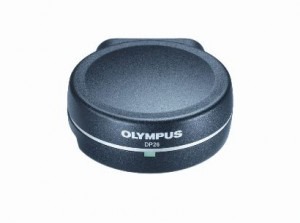
Olympus has released the DP26, a five-megapixel colour digital camera optimised for viewing, documentation, reporting and analysis using a microscope.
The camera can be used to browse a sample using the monitor, utilising a rapid progressive scan readout that provides fluid, natural panning and focusing, and avoids distracting artefacts.
This removes the physical strain imposed by using the eyepieces, improving user comfort and efficiency.
It also facilitates simultaneous sample viewing, whether in research, teaching, medical diagnostics or the inspection and analysis of materials.
A high level of sensitivity ensures that the analysis of darkly stained samples or the use of dark-field illumination yields reliable, accurate images.
In addition, the camera can differentiate subtle colour differences due to the colour-reproducibility level of the sensor.
As part of an integrated microscopy system, the DP26 frees you from the eyepiece and allows you to focus on your data.
By utilising the Olympus DP26 camera, users can comfortably browse and focus on their sample and discuss data with colleagues or students, without needing to use the eyepiece.
Workflow efficiency is improved and prolonged use less physically tiring than when using the oculars, the company claims.
The DP26 generates a live image feed that is fast, fluid and free from distracting artefacts such as image striping or colour ghosts.
This is achieved via the utilisation of a progressive scan mode, which is available at all supported resolutions and utilises a rapid Firewire connection to the computer and monitor.
A frame rate of 16 frames per second or greater is possible at the resolutions offered by most laboratory monitors, providing comfortable live viewing.
For specialist equipment capable of displaying 5 megapixels, the system can provide a refresh rate of seven frames per second.
The colours produced using the DP26 are true to those seen through the eyepieces, with high fidelity guaranteed via the Olympus True Colour function, which is further enhanced when combined with the Olympus True Colour LED light source.
The high sensitivity (ISO 400) of the DP26 makes it suitable for performing phase-contrast/dark-field microscopy or working with darkly stained samples, while the high dynamic range of the system produces vivid, crisp images, rich in detail, Olympus claims.
The DP26 is available in two versions - optimised either for desktop or laptop use.
It is fully supported by all Olympus software, including Cellsens for life-science users and the Olympus Stream series of materials-science software solutions.
Both provide automatic shading correction, rapid white balance adjustment, auto-exposure and measurements tools.
In addition, data is stored and accessed using an intuitive file manager, which records exposure settings, magnification and other parameters for future reference.
The DP26 removes the physical strain of eyepiece-based microscopy by providing a fast, free-flowing live feed for intensive sample browsing or long sessions at a microscope.






